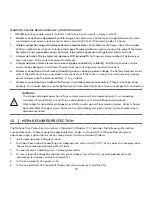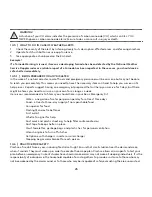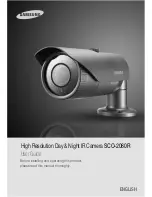
14 | SAFETY PRECAUTIONS
14.1 | CREATE & IMPLEMENT AN ESCAPE PLAN
• Make a floor plan indicating all doors and windows.
• Determine two escape routes from each room.
• Have a family meeting and discuss your escape plan, showing everyone what to do in case of fire.
• Determine a place outside your home where you all can meet in case of an emergency.
• Familiarize everyone with the sound of the smoke and carbon monoxide alarms, explaining what each
alarm sound indicates.
14.2 | WHAT TO DO IN CASE THE SMOKE ALARM SOUNDS
1. If the unit alarms and you are not testing the unit, it is warning you of a potentially dangerous situation
that requires your immediate attention. NEVER ignore any alarm. Ignoring alarm may result in injury or death.
2. If the unit alarms, get everyone out of the house immediately.
14.3 | WHAT TO DO IN CASE OF A FIRE
1. Get out!
2. Don’t panic; stay calm. Follow your family escape plan.
3. Leave the house as quickly as possible. Don’t stop to get dressed or collect anything.
4. Feel doors with the back of your hand before opening them. If a door is cool, open it slowly. Don’t open a
hot door. Keep doors and windows closed, unless you must escape through them.
5. Cover your nose and mouth with a cloth (preferably damp). Take short, shallow breaths.
6. Meet at your planned meeting place outside your home, and do a head count to make sure everybody got
out safely. Call the Fire Department or 911 as soon as possible from outside. Give your address, then your name.
7. Never go back inside a burning building for any reason.
8. Contact your local Fire Department for ideas on making your home safer.
14.4 | WHAT TO DO IN CASE OF CO ALARM
1. Operate test/hush button or use app to silence.
2. Call your emergency services, fire department, or 911.
3. Immediately move to fresh air – outdoors or by an open door/window. Do not re-enter the premises, or move
away from the open door or window until the emergency services responder has arrived, the premises have been
aired out, and your CO alarm returns to its normal condition.
4. After following steps 1 through 3, if your CO alarm reactivates within a 24-hour period, repeat steps 1 through
3 and call a qualified appliance technician to investigate for sources of CO from fuel-burning equipment and
appliances, and inspect for proper operation of this equipment. If problems are identified during this
inspection, have the equipment serviced immediately. Note any combustion equipment not inspected by the
technician and consult the manufacturers’ instructions, or contact the manufacturer directly for more
information about CO safety and this equipment. Make sure that motor vehicles are not, and have not been,
operating in an attached garage or adjacent to the residence.
24








































